

|
| weblog/wEssays archives | home | |
|
How the U.S. Media Failed Homebuyers (October 16, 2007) News Flash! Barn door open, horses gone! This summarizes the U.S. media's pathetic, craven response to the housing bubble which is engulfing the nation. Here is a graphic depiction of media coverage of the housing bubble as it expanded 2000-2005--back when some forward-looking, skeptical coverage might have done some good: 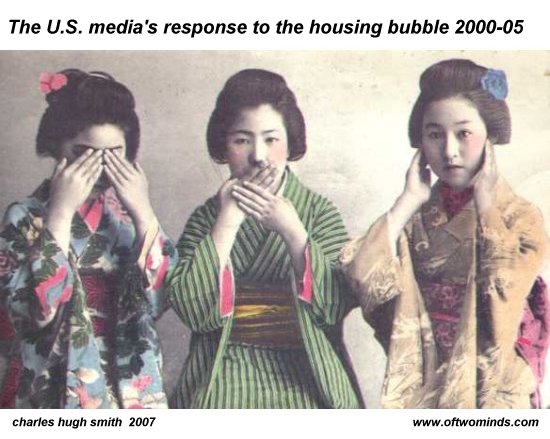
How much coverage was given to the laughably obvious conclusion that the doubling and tripling of house prices (see below) was unsustainable, guaranteeing an eventual decline that would hand the last batch of buyers substantial losses? 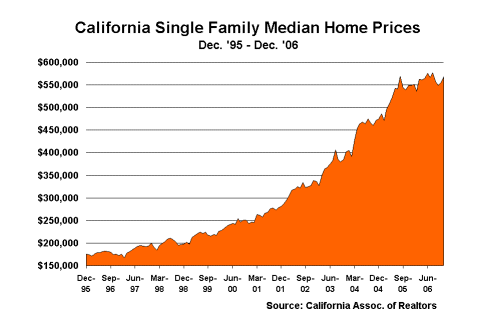
Back on March 1, 2003, the San Francisco Chronicle Home section ran a free-lance article I wrote, All Signs Point To A Top: Has Bay Area real estate finally reached the dreaded category of a "bubble," soon to follow its scorned dot-com cousin over the tipping point into decline? The prognoses of the pundits of residential real estate are mixed, but the consensus is: Steady as she goes. Sales remain brisk, interest rates are low and will probably stay that way, and there is still unmet demand for homes in the "low-end" range (i.e. those in the bargain basement of less than $400,000).OK, so I was early. Would-be flippers could have bought just about any house on March 1, 2003, closed by June and flipped it two years later at the top of the bubble in June, 2005 for a big profit. But hindsight is 20/20, and when readers emailed me, asking for advice, I offered only what was common-sense then and remains common-sense now: compare the total costs of buying with renting, and be careful unless you're buying a house you can actually afford for long-term shelter. My point is simply this: where were the voices of caution and skepticism? Not being published or broadcast much, to be sure. Buying a house is the biggest financial commitment the average American will ever make, and the media has a responsibility to its readers, not just its advertisers--a responsibility it completely abrogated in the inflation of the housing bubble. (Note that as a free-lancer, I pitched the story to my editor--I wasn't assigned the story, nor did the idea come from the newspaper. The coverage, such as it was, came from one underpaid free-lance journalist.) Though I am not blessed with a Lexis-Nexis subscription to prove this, based on my Web searches it is undeniably true that the mainstream print, Internet and broadcast media provided virtually no front-page or equivalent to a forward-looking, skeptical view of the housing bubble or its predictable consequences during the long run-up. The first serious coverage provided by any national news outlet was Harpers cover story in May, 2006 on the bubble's long-term consequence: The new road to serfdom: An illustrated guide to the coming real estate collapse.. Sadly, the bubble top had already occurred nine months before in August 2005. Please don't send me links to stories buried on page C-17 or articles which mentioned housing bubble skeptics in passing only to dismiss them; those are simulacrums of journalism, not coverage. 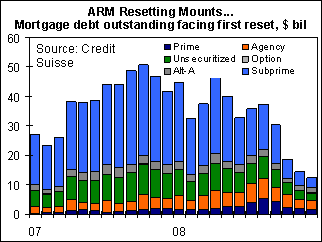 Take a look at this chart, which suddenly appeared everywhere in 2007, eighteen months
after the bubble began bursting. How difficult would it have been for financial-press
journalists or analysts to have produced this graph on page one back in 2004 or 2005?
No harder than it was for them to print it in 2007; the subprime, Alt-A and adjustable
mortgages were being sold and recorded back then.
Take a look at this chart, which suddenly appeared everywhere in 2007, eighteen months
after the bubble began bursting. How difficult would it have been for financial-press
journalists or analysts to have produced this graph on page one back in 2004 or 2005?
No harder than it was for them to print it in 2007; the subprime, Alt-A and adjustable
mortgages were being sold and recorded back then.
Ditto for this chart showing the huge run-up of mortgage equity extractions and the predictable decline which will occur as prices fall and equity is exhausted. Yet how many of these charts did you see in the mainstream media in the years 2002-2005 during the final blow-off stages of the housing bubble? 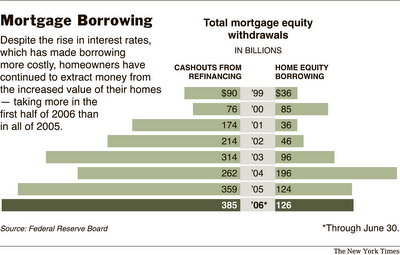
How difficult would it have been for serious publications to look back at the housing declines of the early 90s for some clues about the future of the current bubble? Clearly, the media has been a lapdog of its key advertisers, the housing and lending industries. If the owners and managers of mainstream media outlets deny this, then the truth is even uglier: they are reactive in their "news," devoid of meaningful analysis and incapable or unwilling to look ahead in a journalistically sound, skeptical fashion. Now that the bubble's bursting is getting ugly, the media is pleased to run "if it bleeds (losses and human tragedy), it leads." In other words: Terrible news! Barn door open, horses gone! Where were they when the door was being busted down by duplicious lenders, builders and realtors? Where were they when the guardians of the door (the government agencies pledged, funded and mandated to protect the public) all fell asleep and did nothing? Astute contributor James C. sent in these links to two organizations dedicated to exploring media coverage (or lack thereof): www.fair.org--Advertiser Influence Media Reform Information Center Take a look at this chart from the Center's website and tell me this isn't noteworthy: 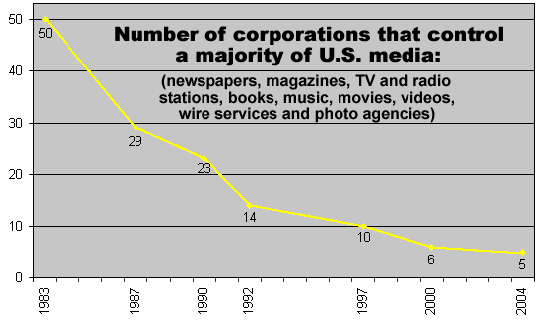
As James succinctly put it: The media have become lapdogs rather that watchdogs. Ownership concentration is the most likely reason.Now that the newspapers and broadcast media are filled with tales of housing-bubble woe, maybe we should start asking: where were you in 2003, 2004 and 2005, when you might have helped educate these now-desperate home buyers/speculators on the risks and the high probability of a housing bubble collapse? Where were your barks as watchdogs? Unfortunately for the nation, the media only wagged its tail as the housing, real estate and lending industries lined their pockets with advertising gold. If it wasn't for patrick.net and a hearty band of bubble bloggers, the nation would have had no coverage whatsoever of this decade-of-woe-to-come issue. Thank you, Robert P., ($10.00) for your much-appreciated donation to this humble site. I am greatly honored by your contribution and readership. All contributors are listed below in acknowledgement of my gratitude. You read about the housing bubble here back in 2005. Your readership is greatly appreciated with or without a donation. For more on this subject and a wide array of other topics, please visit my weblog. copyright © 2007 Charles Hugh Smith. All rights reserved in all media. I would be honored if you linked this wEssay to your site, or printed a copy for your own use. |
||
| weblog/wEssays | home |